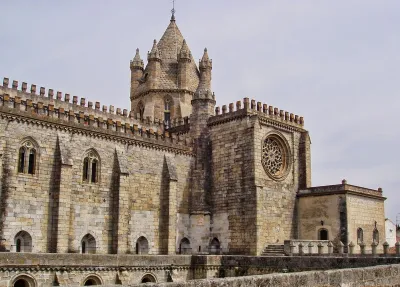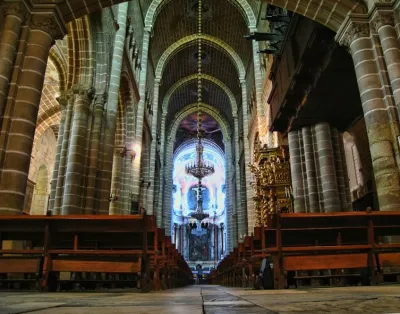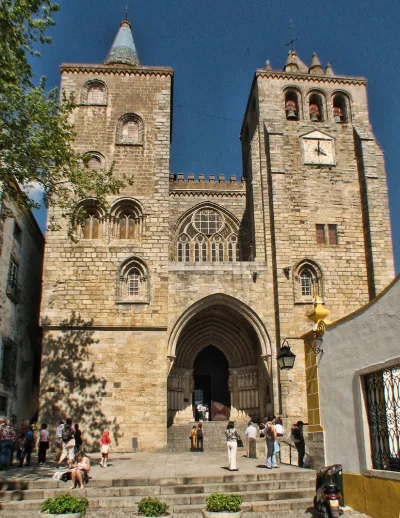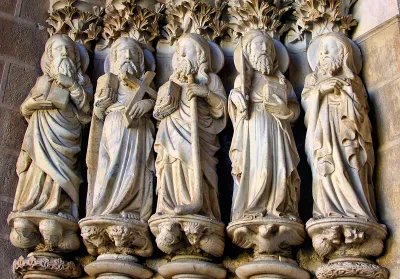
Cathedral cloisters 
Evora Cathedral Karine et Cyril CC BY-SA
Evora Cathedral - Nave and choir 
Evora Cathedral facade 
Sé de Évora - Apostles statues 
Sé de Évora interior Sé de Évora
Évora's imposing cathedral (Sé Catedral de Évora) is situated in the very heart of the old city and the UNESCO World Heritage site. The oldest parts of the building date back to the 12th century, which was when the Moors were finally driven out by the Christians. As a consequence it is no coincidence that this mighty cathedral has certain aspects which resemble a fortress. Probably most people's first view of the cathedral is the façade which looks out over the Évora's main square. The rose granite façade consists of the main entrance portal over which is an impressive Gothic window with period tracery. This is flanked by two great towers which were added in the 16th century. Each tower has different decorative features, with one sporting a bells and a clock, and both topped by conical spires. The Gothic doorway is worthy of note for its Gothic sculptures of the twelve apostles, six on each side of the entrance, which were added in the early 14th century. The building is similar to the cathedral in Lisbon in many respects. The overall floorplan is of a "Latin cross church" with a long nave crossed by a transept to form the cross shape. Also like the Sé in Lisbon are the Gothic rose windows, one featuring the mystical rose and the other the morning star. Set above the cross of the transept and nave is the high lantern-tower with its spire and six turrets, each of which reflects the design of the main tower. Within the cathedral is a high barrel vaulted ceiling with fine Gothic vaulting. However, it is the early 16th century Manueline choir that really draws the attention with its fantastic carved would and painting. There is also a rather unusual sculpture of a pregnant Virgin Mary. The main chapel is a less sombre space and was completely rebuilt in the 18th century during the reign of the spendthrift king João V. It was designed by German architect João Frederico Ludovice who had previously designed the Monastery of Mafra. It is built in the Baroque style and richly decorated in coloured marble. The 14th century Gothic cloisters provide a pleasant space. There is a spiral staircase leading onto a roof terrace from which there are great views out over the Alentejo countryside. Within the cathedral's chapter room is the cathedral museum (Museu de Catedral) which exhibits some of the riches of the medieval church. Along with some fine paintings are the jewel encrusted golden sceptre of Cardinal-King Henrique, a 17th-century reliquary purportedly containing pieces of Christ's Cross and perhaps most bizarre - a small statue of the Virgin Mary, whose midriff opens revealing various scenes from the Bible.
Address
Largo do Marquês de MarialvaEvora7000Phone
+351 266 759 330
Evora travel guide »
Even from a distance the majestic importance of Evora is apparent, its cathedral dominating the view of the famous white and yellow city as it stands atop a hill surrounded by the vast expanses of the Alentejan plain in southeast Portugal. With over two thousand years of history and, therefore, a variety of cultural and architectural influences, Evora is a real national treasure and certainly…